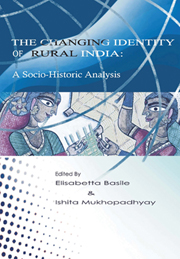Book contents
- Frontmatter
- Contents
- Acronyms and Abbreviations
- About the Authors
- INTRODUCTION
- PART 1 INDIAN RURAL TRANSFORMATIONS
- PART 2 INEQUALITY IN RURAL INDIA
- Social Capital and Poverty Reduction Strategies: The Case of Rural India
- An Overview of Indian Microfinance
- Income-based Estimates vs Consumption-based Estimates of Poverty: Evidence from Rural Tamil Nadu after Liberalization
- Occupational Diversification of the Rural Workers: Some Results from Field Surveys in West Bengal
- Literacy and Externalities in Human Development
- PART 3 SOCIAL MOVEMENTS AND IDENTITIES
- Appendix 1 Socio-Economic Indicators of Rural India
An Overview of Indian Microfinance
from PART 2 - INEQUALITY IN RURAL INDIA
Published online by Cambridge University Press: 05 March 2012
- Frontmatter
- Contents
- Acronyms and Abbreviations
- About the Authors
- INTRODUCTION
- PART 1 INDIAN RURAL TRANSFORMATIONS
- PART 2 INEQUALITY IN RURAL INDIA
- Social Capital and Poverty Reduction Strategies: The Case of Rural India
- An Overview of Indian Microfinance
- Income-based Estimates vs Consumption-based Estimates of Poverty: Evidence from Rural Tamil Nadu after Liberalization
- Occupational Diversification of the Rural Workers: Some Results from Field Surveys in West Bengal
- Literacy and Externalities in Human Development
- PART 3 SOCIAL MOVEMENTS AND IDENTITIES
- Appendix 1 Socio-Economic Indicators of Rural India
Summary
INTRODUCTION
The failure of credit markets in catering to the poor residing in the rural areas of the developing economies is well recognized. The credit markets are particularly problematic because the lenders are unaware of the creditworthiness of the borrowers more often than not. The poor individuals may have workable ideas and relevant experience, but often lack so-called ‘collateral’ to be deposited with the lender and appropriated in case of project failure and possibility of default by the borrowers. The formal sector may enjoy a comparative advantage over the informal sector in intermediating funds over space and reaping scale economics, but it seems to fare worse in solving information and enforcement problems (Besley, 1995). Formal lending institutions mostly cannot accept collateral in non-monetary forms. The informational problems arise because the rural credit markets in developing economies are often characterized by limited liability, in which a borrower repays fully only when the project is successful, but her liability is otherwise limited by her resources. For poor borrowers without any collateral, the repayment is possible only when success comes. In such situations, since the borrowers do not internalize the risk completely, a loan that cannot be properly monitored may be used in overly risky activities or used for some other purpose than what it is primarily intended for. With high monitoring and transaction costs of catering to a large number of poor borrowers in remote rural area, the formal lending institutions see lending to the rural poor as a very risky business.
- Type
- Chapter
- Information
- The Changing Identity of Rural IndiaA Sociohistoric Analysis, pp. 96 - 112Publisher: Anthem PressPrint publication year: 2009
- 1
- Cited by



